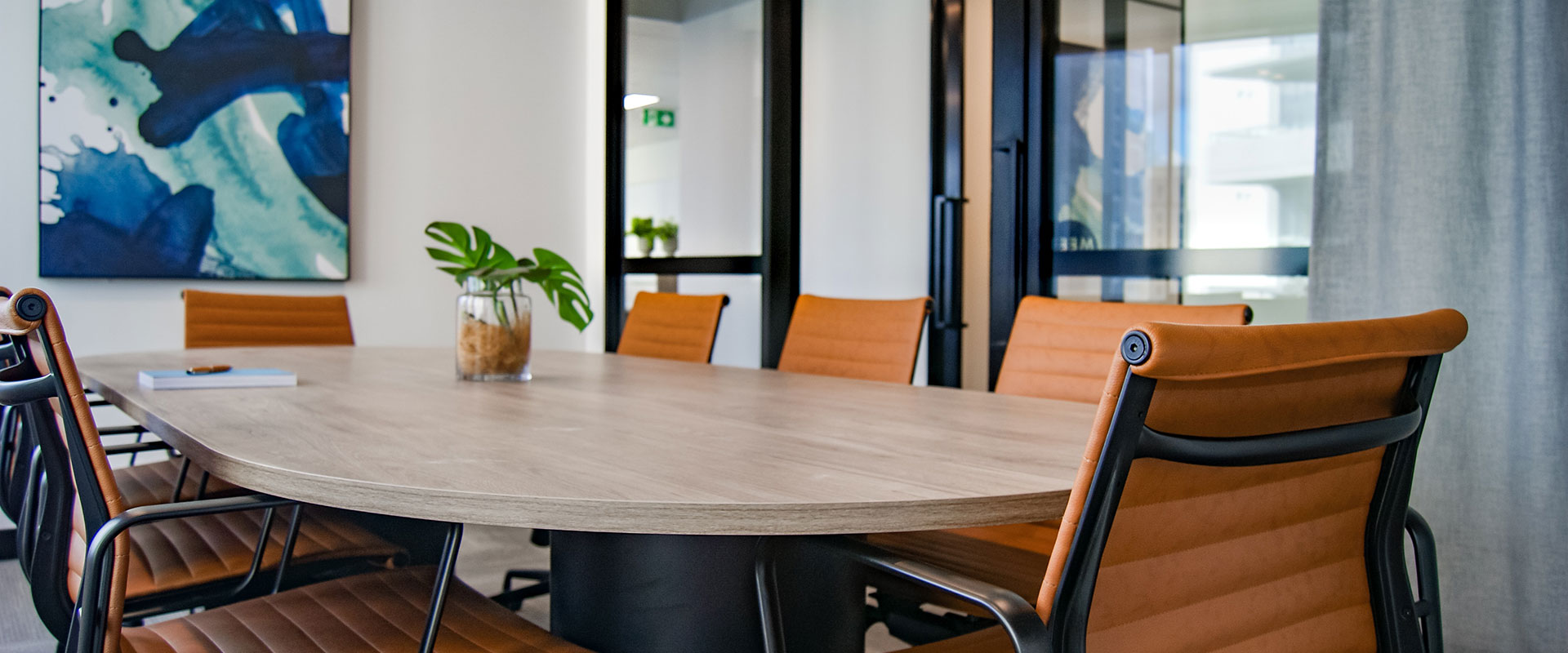The COVID-19 pandemic forced a majority of companies across multiple industries to rethink their workplace environments. Based on data they’ve collected, professionals in the interior design industry believe that the future of corporate design will include flexible arrangements to support short-term reconfiguration and long-term reorganization, based on how — and when — people return to the office.
Flexible Spaces & Open Floor Plans
The buzzword for 2021 interior design: flexibility. Experts predict that post-COVID, many companies will intentionally choose to embrace a hybrid of in-person and remote work. This approach will require reinventing personal and shared spaces.
Modular furnishings will help support the need to modify interior spaces to accommodate more or fewer people. Movable furniture and walls — well equipped with AV equipment for video conferencing — will allow people to create socially-distanced spaces, rearranging as needed for small group or solo use. These configurations naturally create more spaces for employees to work privately and engage in focused work sessions.
Because they allow for both distance and collaboration between a few employees, workstations and desk pods will remain popular furnishing options. While traditional cubicles and assigned desks won’t go the way of the dinosaur, material designers will use easily cleanable, non-porous materials.
Regardless of which office furniture trends companies embrace, experts predict an increase in the use of smart desks and furniture that include integrated technology to support a mobility, efficiency, and effectiveness.
Because COVID-19 experts have determined that outside spaces offer more protection from possible transmission, companies with access to the outdoors may find themselves exploring ways to outfit those spaces, where practical, for solo and collaborative work.
Open floor plans aren’t going away. In many respects, they’re more practical than individual, closed offices. Unenclosed spaces can accommodate meetings or become multipurpose areas, especially when well-equipped with the right technology to support collaboration.
Spacious floor plans facilitate cleaning, make it easier to limit high-touch surfaces, and provide easier ventilation. For example, it’s easier — although still costly — to upgrade a building’s HVAC and ventilation systems for one space than multiple, smaller, closed-off spaces. While beneficial for controlling COVID, studies have also shown that better air quality leads to higher employee productivity.
Furniture, Fixtures & Technology
Future proofing with adaptable furniture makes good financial sense, too. It’s lightweight and easily moved or reconfigured. Larger companies may opt to install multiple refrigerators and dishwashers at the department level to cut down on germs or contamination.
Cleanability will become more critical than ever. Healthcare systems often install acrylic solid surface furniture because it’s non-porous and microbial-resistant. Its homogeneous construction allows manufacturers to eliminate seams and substrates which can make cleaning difficult.
Materials like microfiber, solid acrylic, glass, bamboo, vinyl, leather, concrete, and others offer maintenance-friendly characteristics like:
- Scratch resistance
- Moisture-resistant
- Impermeability
- Resistance to industrial cleaners
Finishes will include self-cleaning surfaces, a class of materials capable of removing bacteria and dirt. Companies now make skins or mats that turn high-traffic touch points — like light switches, elevator buttons, and door handles — into continuous self-cleaning surfaces.
Expect an increase in touchless technology, too, like:
- Motion lights/ sensors
- Automatic doors
- Keyless entry
- Voice-activated or smart-phone controlled elevators or AV systems
- Apps for environmental control
Defined Personal Space
While industry experts feel that the open plan is here to stay, companies will need to address personal spaces. It’s possible that hoteling (not assigning desks/ workspaces to specific individuals) will continue, but in the near future, it’s more likely that companies will create dedicated, defined personal space for their employees.
Installing cubicles with higher walls will afford better division and shielding. Designers favor materials that allow light and a healthy air flow. Laminate, acrylic, marker board, and glass work well because they support quick, easy disinfecting throughout the day.
Protective screens manufactured from clear or frosted acrylic also encourage collaboration and social interaction. Experts recommend a screen or wall height of 62” or more. Add-on dividers or sliders, like desk-mounted and mobile screens should provide a minimum of 24” of shielding above the desktop.
Psychology of Color
We can’t forget color, which plays a critical role in interior design. Colors that represent nature can bring a sense of comfort, peace, and encouragement to counterbalance feelings of stress, unrest, or worry. Soft, subtle, cool colors also offer a welcome respite for eyes spending many hours focused on computer screens.
Bright, bold color schemes that include ranges of teal, pink, or yellow encourage and support positivity and energy.
Color experts see a rise of harmonious palettes that support unity and togetherness. The gradient trend popular for the past few years will continue to shift into a more analogous palette of colors that blend easily together.
Monochrome palettes, popular in 2020, have evolved to include a single contrast shade within the greyscale designs. It’s an approach that adds a pop of color without going overboard, keeping things simple with just a touch of bold shade.
2021 and Beyond
Natural light, plants, spaces to relax, comfort, functionality, and individuality… each of these concepts applies to corporate design for 2021. Many companies and organizations will continue to embrace the open space concept, which supports the current pandemic conditions with social distancing requirements and more easily-ventilated air. Cubicle manufacturers continue to improve their products, too, adding screens and other mobile dividers designed to protect workers.
New office furniture trends include movable, mobile furniture, which affords flexibility to arrange spaces to suit needs, whether for small group meetings, temporary workstations or quiet/ privacy zones.
While past designs may have emphasized productivity almost to the exclusion of everything else, a happier — and more satisfying trend — continues to incorporate emotional and physical wellbeing into the latest designs.
Whether you’re exploring new options for a complete interior design overhaul, looking to upgrade to more ergonomic or green furniture, our corporate and office CREA United members can help. We offer the knowledge and experience to collaborate with you and find unique solutions that meet your needs.

